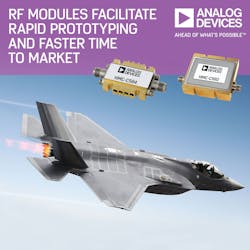During an electronic design conference in Boston this week, Analog Devices underlined the fact that engineers are increasingly dropping modules into things like satellites and telecommunications equipment, instead of undertaking the difficult task of plotting out radio circuits.
On Tuesday, the Massachusetts-based chipmaker announced the release of several new radio frequency modules. The devices are not only hermetically-sealed but also contain replaceable and removable connectors for linking them to other circuits. The modules can be seen this week at the Electronic Design Innovation Conference, also known as EDI CON.
Bryan Goldstein, the general manager of Analog Devices’ Aerospace and Defense business, said that the modules can be used to build prototypes faster than it would take engineers to sculpt a wireless system from scratch. They are designed for electronic warfare, radar, airplanes, and wireless test equipment, and telecommunications.
The HMC-C582 is a power amplifier module covering a frequency range between 0.01 and 20 GHz. Based on a gallium arsenide monolithic microwave integrated circuit, it provides 24 dB of gain and up to 26 dBm of output power at 1 dB gain compression, according to a preliminary datasheet.
The HMC-C583 is a single-pole, single-throw switch operating with a frequency range from 0.1 to 40 GHz. Its switching speed is typically 10 nanoseconds, with an insertion loss of 7 dB and isolation of 50 dB. It is based on gallium arsenide semiconductors fabricated on a pseudomorphic high electron mobility transfer, or pHEMT, process.
The next product is the HMC-C584, a digital attenuator with a frequency range between 0.1 GHz and 40 GHz. Based on gallium-arsenide semiconductors, the device features a typical insertion loss of 7 db and a total attenuation range of 31 dB. It uses control voltage inputs between 0V and 5V to select attenuation states.
The HMC7891 is a limiting amplifier module that provides saturated output power of 13 dBm with inputs ranging from -30 to 10 dBm. Featuring 47 dB gain and operating between 2 and 18 GHz, it can also be configured as a frequency tripler.
Analog Devices is providing some support and customization to the new parts. “If required, ADI can perform additional levels of screening such as radiation hardening to ensure complete compliance for space-related applications,” said Goldstein.
About the Author

James Morra
Senior Editor
James Morra is the senior editor for Electronic Design, covering the semiconductor industry and new technology trends, with a focus on power electronics and power management. He also reports on the business behind electrical engineering, including the electronics supply chain. He joined Electronic Design in 2015 and is based in Chicago, Illinois.

